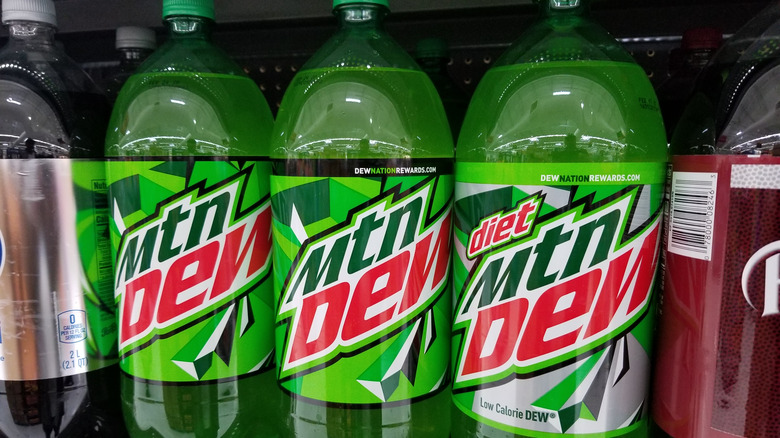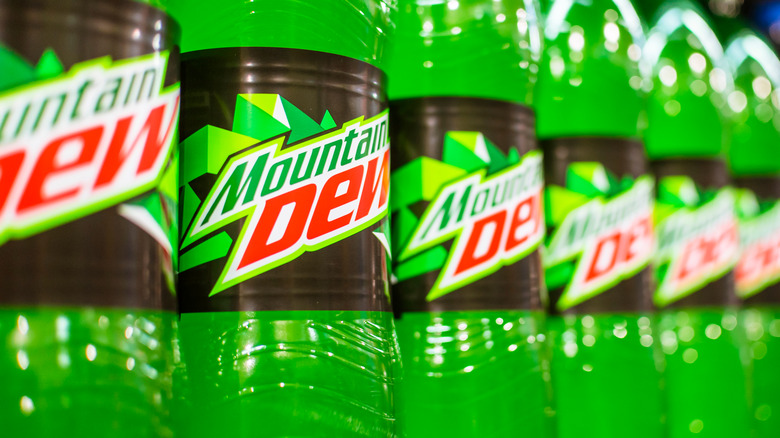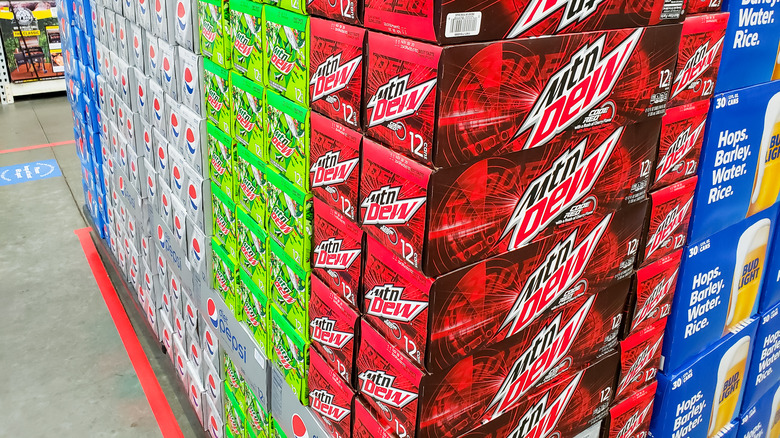Does Mountain Dew Even Have A Flavor?
Do you "do the Dew"? A lot of people do, since Mountain Dew is PepsiCo's second most popular soft drink, according to Sure Dividend. This florescent green soda was first introduced by the Tip Corporation in Knoxville, Tennessee, in 1940. The original formula was created by Barney and Ally Hartman and it was initially marketed as a mixer for whiskey and other spirits, but it quickly gained popularity as a standalone drink.
Mountain Dew was bought by PepsiCo in 1958 and kept growing from there. Today, it is one of the most popular soda brands in the world and it has become a cultural icon, with a devoted following of fans who appreciate its distinct taste. But Does Mt. Dew even have flavor? Some people describe it as a citrusy sweet flavor, with hints of lemon, lime, and orange, and the PepsiCo itself says the soda has a "one-of-a-kind citrus taste," but trying to fully describe the flavor can be difficult.
The various flavors of Mountain Dew
The classic Mountain Dew flavor is hard enough to describe, but PepsiCo made things even harder with its new Mountain Dew products. In the 1980s, the company introduced a variant of the soda called "Mountain Dew Code Red," which combines the citrus flavor of the classic drink with a hint of cherry flavor. The overall taste is sweet with a slight tanginess, similar to cherry cola or a cherry-flavored energy drink. And they didn't stop there.
Over the years, PepsiCo has introduced many variations of Mountain Dew, including limited-edition and regional flavors. Some of the most popular include Mountain Dew Voltage, Mountain Dew White Out, Mountain Dew Pitch Black, Mountain Dew Baja Blast, and Mountain Dew Kickstart. Each of these have that citrus-based flavor of the original Mountain Dew, but with distinct differences. For example, Baja Blast combines the classic lemon-lime citrus flavor of Mountain Dew with pineapple and mango flavors for a more tropical taste. Mountain Dew Pitch Black, on the other hand, combines that citrus flavor with a hint of black grape, for a subtle grape flavor that gives it a richer taste than regular Mountain Dew. Some people describe it as being similar to a grape-flavored soda.
Mountain Dew is banned in many countries
Mountain Dew, like many other soft drinks, contains caffeine, sugar, and artificial ingredients, which all work together to make up its distinct flavor and color. Some countries once banned or restricted the use of certain ingredients found in Mountain Dew due to safety concerns. For example, that green citrus soda you love so much used to contain Brominated Vegetable Oil (BV), which was originally used as a flame retardant for carpets. According to Scientific America, these chemicals can build in your body and have adverse affects on your health. BVO was used in Mountain Dew to ensure that the citrus oils used in the recipe don't separate and float to the top of the soda bottle. PepsiCo stopped using BVO in all of its drinks in 2020, according to the company's Twitter page.
It's also important to note that Mountain Dew's original formula has 54 milligrams of caffeine per every 12 ounces of the drink, making it one of the highest- caffeinated sodas on the market. By comparison, Coca-Cola only has 34 milligrams of caffeine per 12 ounces. Mountain Dew sold in countries that restrict caffeine in soft drinks may have lower or no caffeine content, which could impact its formula and overall flavor.


